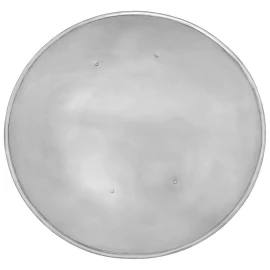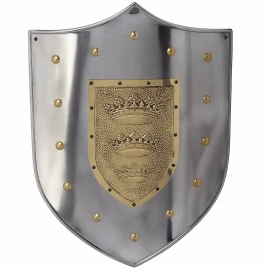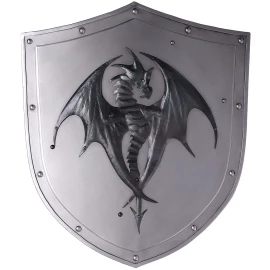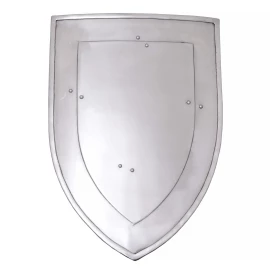Metal shield with red Calatrava Cross
Medieval shield, Swiss style with three upper points and finish point at the bottom. It is decorated with the Cross of Calatrava Order, a Greek cross of gules, with his arms in the shape of lilies. More information...
Notify me when the item is in stock.
We will inform you as soon as we stock up.
Metal shield with red Calatrava Cross
Please note: This is just an ornamental item, not intended for real use!
- Length 62cm
- Width 47cm
- Thickness measured at the edge 1.21mm
- Weight approx. 2500 g
- Metal chain on the back
- Handmade
- Red Calatrava Cross in the heart of the Shield.
- Adorned with brass studs along the edge.
High-quality Shield of the Exclusive Collection of “Historic Shields” made by MARTO®
Certificate of Origin and Quality. Made in Toledo.
The Order of Calatrava was one of the four Spanish military orders and the first military order founded in Castile, but the second to receive papal approval. The papal bull confirming the Order of Calatrava was given by Pope Alexander III on September 26, 1164. Most of the political and military power of the order dissipated by the end of the 15th century, but the last dissolution of the order's property did not occur until 1838.
A shield is a type of personal armor, meant to intercept attacks, or redirecting a hit from a Sword mace, battle axe.
Shields vary greatly in size and in thickness ranging from large panels that protect the user's whole body to small models that were intended for hand-to-hand-combat use.
In prehistory and during the era of the earliest civilizations, shields were made of wood, animal hide, woven reeds or wicker
In the Middle Ages, timber, leather or rawhide and often reinforced with a metal boss, rim or banding.
They were carried by foot soldiers, knights and cavalry.
Shields could be round, oval, square, rectangular, triangular.
The shield was held by a central grip or by straps that went over or around the user's arm.
Often shields were decorated with a painted pattern or an animal representation to identify their army or clan. These designs developed into systematized heraldic devices during the High Middle Ages for purposes of battlefield identification.
We are here for you




































